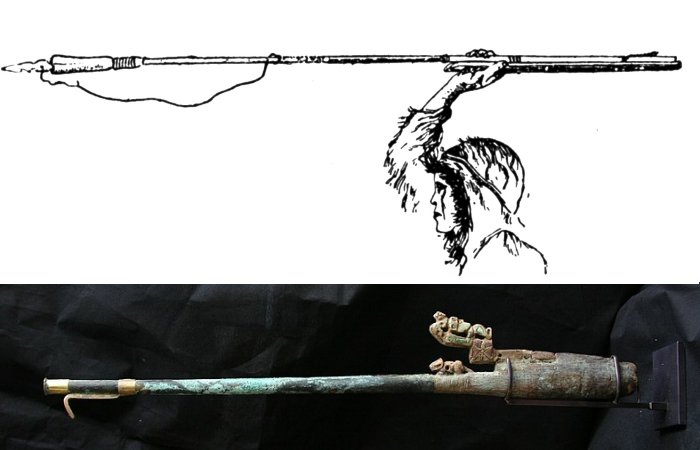Jan Bartek – AncientPages.com – A new study has demonstrated that the atlatl (i.e., spear thrower) functions as an “equalizer,” a finding which supports women’s potential active role as prehistoric hunters.
The atlatl is a handheld, rod-shaped device that employs leverage to launch a dart, and represents a major human technological innovation used in hunting and warfare since the Stone Age. The first javelins are at least hundreds of thousands of years old; the first atlatls are likely at least tens of thousands of years old.

Top: The use of the Atlatl weapon. Credit: Wikipedia – Public Domain – Below: Ceremonial spear thrower, Peru, 1–300 A.D. Credit: Lombards Museum – CC BY 3.0
“One hypothesis for forager atlatl adoption over its presumed predecessor, the thrown javelin, is that a diverse array of people could achieve equal performance results, thereby facilitating inclusive participation of more people in hunting activities,” said archaeologist Michelle Bebber, Ph.D., an ᴀssistant professor in Kent State University’s Department of Anthropology who led the study
Bebber’s study tested this hypothesis via a systematic ᴀssessment of 2,160 weapon launch events by 108 people, all novices, (many of which were Kent State students) who used both javelins and atlatls. The results are consistent with the “atlatl equalizer hypothesis,” showing that the atlatl not only increases the velocity of projectile weapons relative to thrown javelins, but that the atlatl equalizes the velocity of female- and male-launched projectiles.
“This result indicates that a javelin to atlatl transition would have promoted a unification, rather than division, of labor,” Bebber said. “Our results suggest that female and male interments with atlatl weaponry should be interpreted similarly, and in some archaeological contexts females could have been the atlatl’s inventor.”
“Many people tend to view women in the past as pᴀssive and that only males were hunters, but increasingly that does not seem to be the case,” Bebber said. “Indeed, and perhaps most importantly, there seems to be a growing consilience among different fields—archaeology, ethnography, and now modern experiments—that women were likely active and successful hunters of game, big and small.”
Since 2019, every semester Bebber takes her class outside to use the atlatl. She noticed that females picked it up very easily and could launch darts as far as the males with little effort.
“Often males became frustrated because they were trying too hard and attempting to use their strength to launch the darts,” Bebber said. “However, since the atlatl functions as a simple lever, it reduces the advantage of male’s generally greater muscle strength.”
See also: More Archaeology News
“Given that females appear to benefit the most from atlatl use, it is certainly within the realm of possibility that in some contexts females invented the atlatl,” Bebber said. “Likewise, in some primate species, females invent tool technologies for hunting as documented among the Fongoli chimpanzees.”
The study was published in the journal Scientific Reports
Written by Jan Bartek – AncientPages.com Staff Writer





